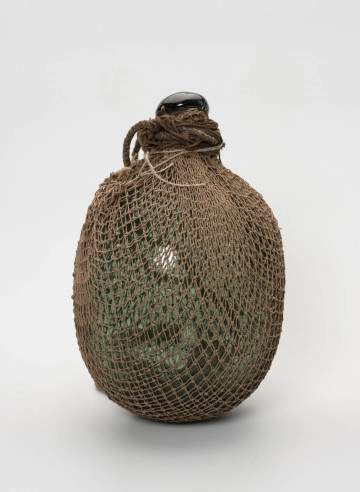
Float
1901 — 1949
National Museum in Szczecin
Part of the collection: Traditional fishing
In the past, a fishermen's activities and daily routine did not end with fishing. The fishing gear used had to be cleaned and dried, and the nets also had to be untangled so that they were ready for use again. Unlike today's nets, which are made of synthetic threads, the nets traditionally used were made of organic fibres, in which the risk of rapid onset of decay processes is much higher. Fishermen used special rods strung along the shore of the marina to hang their nets to dry. To prevent the nets from falling off the rods, they were fastened with wooden clamps, popularly known as buckles, usually rectangular in shape with a triangular cut-out in the middle. Although these were ancillary tools made by the fishermen themselves, they differed little from the laundry-hanging clothespins used by housewives of the time. The fishing collection of the Pomerania Ethnography Department of the National Museum in Szczecin contains 6 fishing net hanging buckles. Five bear the engraved ownership marks of fishermen in the form of linear decoration. The featured buckle, with an interesting curved V-shape, has an inscription in red paint next to the ownership mark, which is the former inventory number of the pre-war Pomeranian State Museum in Szczecin (Pommersches Landesmuseum in Stettin), which was active between 1927 and 1945. Ethnographic collections, including those relating to Pomeranian fisheries, were one of the four main branches of the institution's collections. Małgorzata Kłosińska-Grzechowiak
Other names
buckle
Author / creator
Object type
buckle, fishing tackle
Technique
planing, curving (engraving)
Material
wood
Origin / acquisition method
acquisition
Creation time / dating
Creation / finding place
Owner
Muzeum Narodowe w Szczecinie
Identification number
Location / status

nieznana
1901 — 1949
National Museum in Szczecin

unknown
1901 — 1939
National Museum in Szczecin

unknown
1901 — 1950
National Museum in Szczecin
DISCOVER this TOPIC
Castle Museum in Łańcut
DISCOVER this PATH
Educational path
0/500

We use cookies to make it easier for you to use our website and for statistical purposes. You can manage cookies by changing the settings of your web browser. More information in the Privacy Policy.
We use cookies to make it easier for you to use our website and for statistical purposes. You can manage cookies by changing the settings of your web browser. More information in the Privacy Policy.
Manage cookies:
This type of cookies is necessary for the website to function. You can change your browser settings to block them, but then the website will not work properly.
WYMAGANE
They are used to measure user engagement and generate statistics about the website to better understand how it is used. If you block this type of cookies, we will not be able to collect information about the use of the website and we will not be able to monitor its performance.